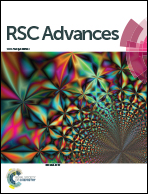Active layer thickness across the crack plane and fracture energy consumption in polymer nanocomposites: adhesion against tear strength†
Abstract
The tear strength of a model methyl methacrylate–butyl acrylate copolymer containing 30 wt% methyl methacrylate (MBC30) and its adhesion strength to poly(ethylene terephthalate) were determined to be 10.2 and 0.26 kN m−1, respectively. The addition of 5 wt% mono-size, 180 nm in diameter, soft nanoparticles of poly(styrene-co-acrylonitrile) with 30 wt% acrylonitrile (SAN70) through latex blending, followed by drying, amplified the adhesion strength while reducing the tear strength. Mild and harsh annealing of the nanocomposite led to partial and full deterioration of work of failure per unit volume (WoF), resulting in augmented adhesion and tear strengths followed by their severe decline, respectively. The G0(1 + ϕ) model-based partitioning of interfacial and bulk fracture energies of the annealed nanocomposites into intrinsic energy × viscoelastic dissipation led to minimum active layer thicknesses of 0.46 and 33.5 nm across the crack plane, respectively. They implied extension of three consecutive C–C bonds or 70% of the matrix entanglement-to-entanglement strand contour length, respectively, corresponding to maximum WoF.


 Please wait while we load your content...
Please wait while we load your content...